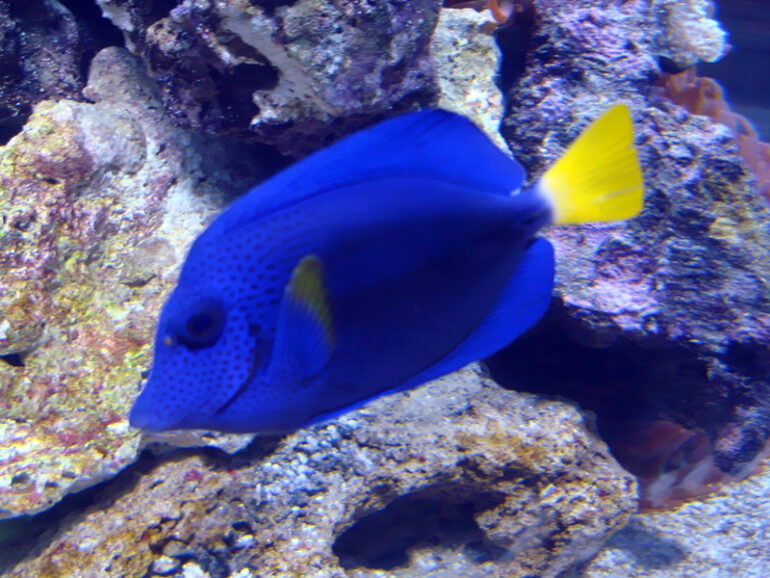When it comes to vivid coloration, the purple tang (Zebrasoma xanthurum) is arguably in a class all by itself. This resplendent Red Sea showstopper has won a special place in Chris’s heart and, given appropriate housing, tankmates, and nutrition, might just prove to be a wonderful focal point for your saltwater aquarium. Through its herbivorous habits, it can also help control the growth of irksome algae in your system.
Physical attributes
In common with all its Zebrasoma cousins, Z. xanthurum has a (highly) laterally compressed body, a sail-like dorsal fin and equally impressive anal fin, and an elongated snout. True to its common name, this species sports intense purple to deep-blue overall coloration with bright yellow on the caudal fin and the margins of the pectoral fins. The anterior portion of the body is adorned with dark dots, and the flanks bear dark, thin, scribbled horizontal lines. A sharp, scalpel-like spine—that can be used to wound tankmates as well as hobbyists’ hands if they aren’t careful—is located on each side of the caudal peduncle (base of the tail).
Proper housing
Z. xanthurum can top out at around 10 inches in maximum length and is a fast, highly energetic species. A good-sized aquarium—a minimum of around 125-gallons—with ample open swimming space is recommended to accommodate an adult specimen.
Highly oxygenated water and copious turbulent circulation are critical for this species as well, so don’t skimp on powerheads and other sources of water movement. Frequent, substantial water changes and vigorous protein skimming must be provided to keep dissolved nutrients to a minimum.
Tankmates
The purple tang can be quite pugnacious toward conspecifics (members of its own species), congeners (other members of its genus), and more or less any other fish that is similar in body shape, color, or dietary habits. Generally speaking, it’s best to leave other tangs (a.k.a. surgeonfishes) out of a tank containing Z. xanthurum as well as other laterally compressed herbivores, such as rabbitfishes. Ideally, a purple tang should be the last specimen introduced to your system. As the “new kid on the block,” it will be less inclined to behave aggressively toward tankmates.
Corals and other sessile invertebrates are usually safe around the purple tang, though it may nip at and irritate fleshier species (sometimes to the point that they’ll keep their tissues retracted) as it grazes around the tank.
Feeding
Z. xanthurum is decidedly herbivorous and demands frequent meals rich in veggie matter, such as frozen herbivore formulas, dried seaweed sheets (e.g., green marine algae, red marine algae), spirulina-based foods, and live macroalgae.
Don’t let water quality slide!
In addition to providing proper veggie-based nutrition, the key to maintaining a happy, healthy, and splendidly colorful purple tang is keeping water quality in tip-top condition. Purple tangs are especially vulnerable to developing a condition called head and lateral line erosion, or HLLE (the development of pits and lesions around the head and along the lateral line), when subjected to improper environmental conditions. If you get lax when it comes to water changes and other routine maintenance chores, your specimen may very well manifest this condition.




thanks for the great site, just love it, very informatable , keep it up
Thanks Heather. Great to hear you’ve found it helpful!